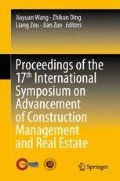Abstract
China’s rapid urbanization, characterized by large-scale rural–urban migration and radial expansion of urban built-up areas, has produced a new type of urban neighborhood, namely the chengzhongcun. With access to an unique micro second-hand housing transactions database which the number of samples is more than 20 thousands during the period from 2006 to 2011 in Beijing, and the list of the 50 key villages which was announced by the government in 2010, we first develop a hedonic housing price model to investigate whether the proximity to urban villages affects the selling price of urban housing units, and then use a DID-Hedonic model specification to examine the effect of the redevelopment project on the surrounding housing price. Controlling for the structure, other characteristics of urban housing units, the time trend and the spatial fixed effect, we find that housing prices are lower the closer the buildings are from urban villages. Further, the housing units near the villages do enjoy a higher increase in price after the announcement of the redevelopment projects. Both of the results are significant at 1 % level. This may indicate a significant negative externality of urban village to its neighbors.
Access this chapter
Tax calculation will be finalised at checkout
Purchases are for personal use only
Notes
- 1.
Apart from the negative effects mentioned above, the citizens also approve of the positive functions of urban villages such as cheap daily commodities and services, such as cleaning staff and security guards.
- 2.
The urban villages in Beijing can be classified into two types: the first type refers to the nooks of the city which are in the built-up area with poor hygiene condition and social security; the second refers to the administrative villages in urban planning areas, most of which are located in rural-urban fringe zones. The differences of the two lie in the land ownership, size and location. The land of the first type is state owned while the second is rural collective owned. As for the size and location, the first villages are mainly small ones close to the center of the city (within 4th Ring Road or even 3rd Ring Road) while the latter are large ones where many immigrants are settled and are further form the city center (most are out of the 4th ring road of Beijing).
- 3.
Due to the lack of information, we cannot get detailed information about the location of all the urban villages in Beijing. According to the survey by Beijing Liquidity Management Committee in 2009, the number of villages with more than 10,000 immigrants has reached 81 [10]. Thanks to the vigorous promotion of renovation programs and news reports, we are able to collect some key facts of the villages.
- 4.
The information includes features like the transaction price, project name of the house, location, etc. and housing structural features like the area, house age, house type, floor, orientation, decoration, etc.
References
Yan Song, Yves Zenou (2012) Urban villages and housing values in China. Reg Sci Urban Econ 42:495–505
Peilin Li (2002) Great changes: the end of the village – research on the villages in city. Soc Sci China 1:168–179
Siqi Zheng, Fenjie Long, Cindy Fan, Yizhen Gu (2009) Urban villages in China: a 2008 survey of migrant settlements in Beijing. Eurasian Geogr Econ 50(4):425–446
Zongmin Lan, Jian Feng (2012) The spatial structure of floating population’s daily activities – based on a survey of a number of typical villages in Beijing. Geogr Sci 32(4):409–417
Li Zhang, Zhao SXB, Tian JP (2003) Self-help in housing and Chengzhongcun in China’s urbanization. Int J Urban Reg Res 27(4):912–937
Fenghua Wen, Lixun Li, Guoqiang Xu (2007) An analysis of the externality of urban-village and its internalization. Mod Urban Stud 8:81–87
Yilin Zhao (2011) The negative externalities of urban village and its governance mechanisms. North Econ Trade 11:33–34
Siqi Zheng, Junping Liao, Rongrong Ren, Yang Cao (2011) Housing policy for migrant workers and economic growth. Econ Res 2:73–86
Xiaoming Wang, Jun Yang, Ming Li. (2009) The positive externalities of urban village and its redevelop measures. China Real Estate 9:46–47
Xiaoying Feng (2010) Transformation of urban village and cooperative governance of the floating population concentrated communities in Beijing. Popul Res 34(6):55–66
Acknowledgments
This research is supported in part by the National Natural Science Foundation of China (No. 70973065), Major project of National Social Science Foundation of China (No. 09&ZD042) and Tsinghua University Initiative Scientific Research Program.
Author information
Authors and Affiliations
Corresponding author
Editor information
Editors and Affiliations
Rights and permissions
Copyright information
© 2014 Springer-Verlag Berlin Heidelberg
About this paper
Cite this paper
Zhang, Y., Zheng, S., Sun, C. (2014). What’s the Effect of Urban Villages on Commercial Housing Price? An Analysis Based on Second-Hand Housing Transactions in Beijing. In: Wang, J., Ding, Z., Zou, L., Zuo, J. (eds) Proceedings of the 17th International Symposium on Advancement of Construction Management and Real Estate. Springer, Berlin, Heidelberg. https://doi.org/10.1007/978-3-642-35548-6_19
Download citation
DOI: https://doi.org/10.1007/978-3-642-35548-6_19
Published:
Publisher Name: Springer, Berlin, Heidelberg
Print ISBN: 978-3-642-35547-9
Online ISBN: 978-3-642-35548-6
eBook Packages: Business and EconomicsBusiness and Management (R0)

